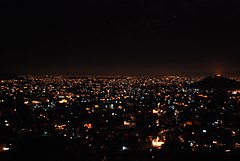
Back تيهار Arabic তিহাৰ Assamese तिहार DTY تیهار Persian Tihar Galician ティハール Japanese तिहार Nepali ਤਿਹਾਰ (ਤਿਉਹਾਰ) Punjabi Tihar (festival) SIMPLE
| Tihar | |
|---|---|
 Night view of the Kathmandu city during the festival (2009) | |
| Also called | Bhai Tika, Deepawali, Yamapanchak |
| Type | Religious |
| Celebrations | Decorating homes with lights, gathering, worshipping, singing and dancing (Deusi Bhailo), gambling, feasts |
| Observances | Prayers and religious rituals |
| Begins | Kārtika māsa kṛṣṇa pakṣa trayodashi tithi |
| Ends | Kārtika māsa śukla pakṣa dwitiya tithi |
| 2023 date | 11th November, Saturday to 15th November, Wednesday |
| Frequency | Annual |
| Related to | Diwali, Diwali (Jainism), Bandi Chhor Divas, Swanti, Sohrai, Bandna |
Tihar (also known as Deepawali and Yamapanchak) is a five-day Hindu festival of Diwali celebrated in Nepal and the Indian regions of Sikkim and Gorkhaland (particularly the towns of Darjeeling and Kalimpong), which host a large number of ethnic Indian Gorkhas
Diwali is referred to as Tihar in Nepal, Sikkim and Gorkhaland and is marked by lighting diyo inside and outside the home but unlike Diwali in other parts of India, the five days of Tihar include celebration and worship of the four creatures associated with the Hindu god of death Yama, with the final day reserved for people themselves.[1] According to the Vikram Samvat calendar, the festival begins with Kaag (crow) Tihar on Trayodashi tithi of Kārtika kṛṣṇa pakṣa (the 13th day of the waning moon) and ends with Bhai Tika on Dwitiya tithi of Kārtika śukla pakṣa every year.[2] In the Gregorian calendar, the festival falls sometime between October and November every year.[3]
- ^ Burbank, Jon, 1951– (January 2014). Nepal. ISBN 978-0-7614-8021-1. OCLC 1046067057.
{{cite book}}: CS1 maint: multiple names: authors list (link) CS1 maint: numeric names: authors list (link) - ^ "Kaag Tihar: When crow are worshiped". nepaltraveller.com. Retrieved 29 September 2020.
- ^ Nepal, Naturally. "Tihar". www.welcomenepal.com. Retrieved 29 September 2020.
© MMXXIII Rich X Search. We shall prevail. All rights reserved. Rich X Search